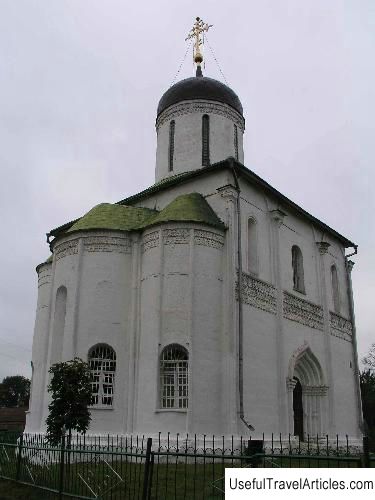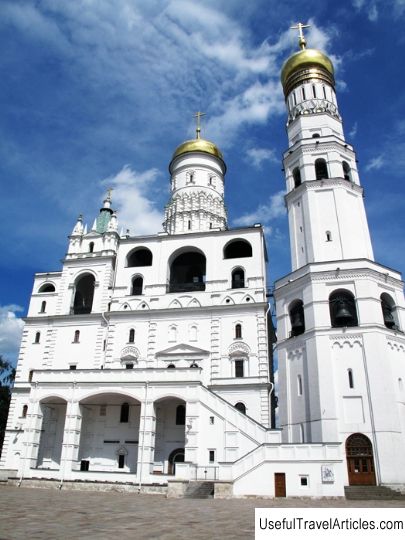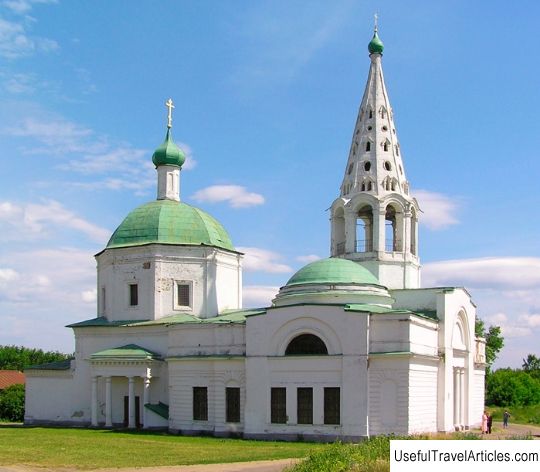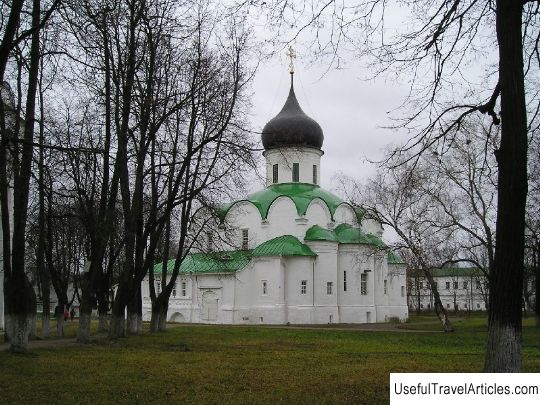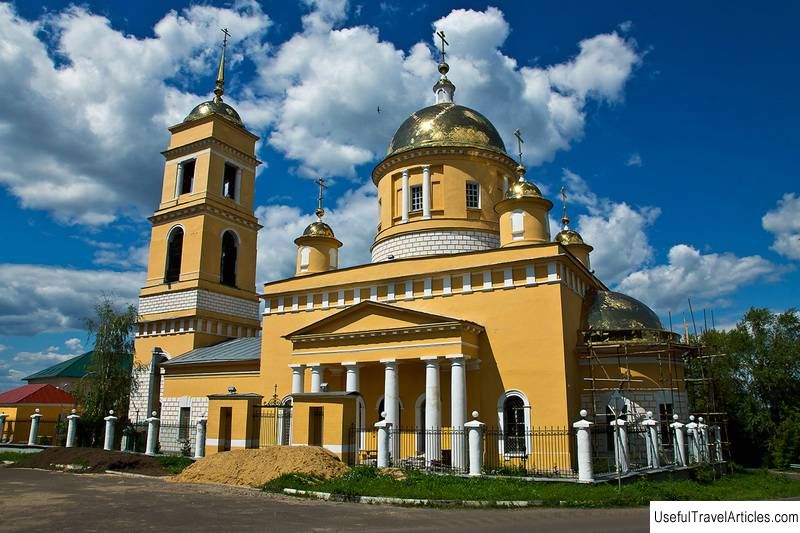Kremlin Assumption Cathedral description and photos - Russia - Moscow: Moscow
Rating: 7,9/10 (7900 votes) 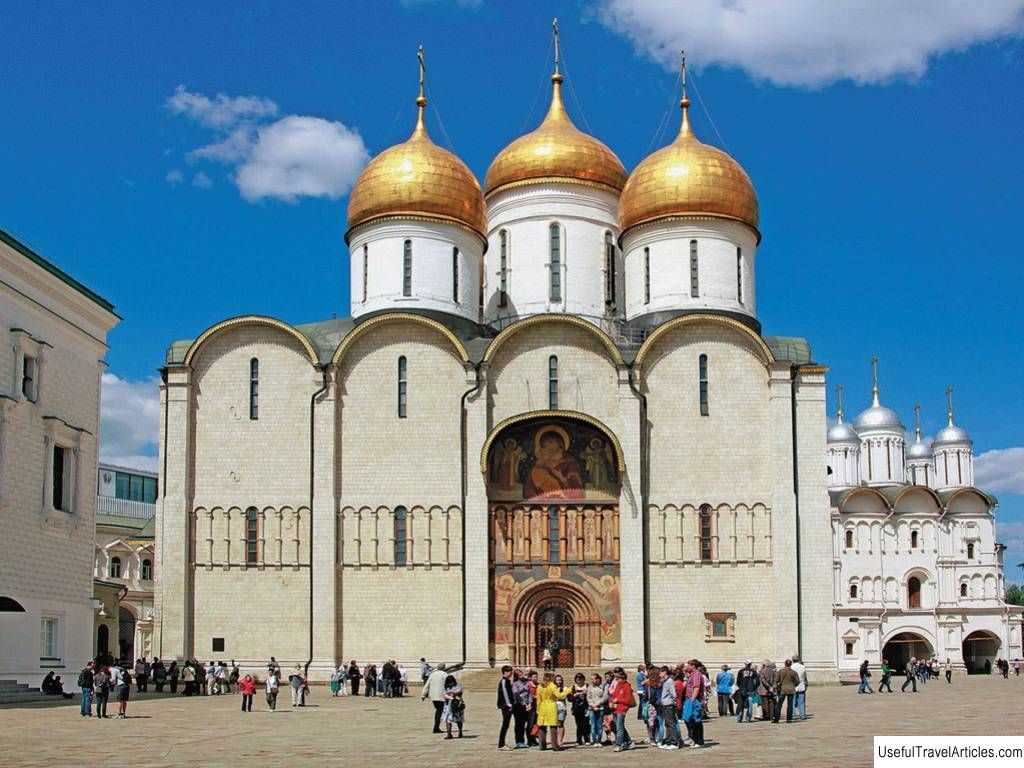
Kremlin's Assumption Cathedral description and photos - Russia - Moscow: Moscow. Detailed information about the attraction. Description, photos and a map showing the nearest significant objects. Photo and descriptionOne of the most significant Orthodox churches in Russia and the world, Assumption Cathedral of the Moscow Kremlin was built in the second half of the 15th century . Today the temple is part of the State Historical and Cultural Museum-Reserve "Moscow Kremlin" and the oldest of the fully preserved architectural structures of the capital of the Russian Federation. Construction of the Assumption CathedralThe first Assumption Cathedral appeared in the capital after the Metropolitan of Kiev and All Russia transferred the throne to Moscow from Vladimir. This happened in 1326 under Ivan Kalita . The temple looked like the churches of Suzdal and Vladimir - one-domed, crowned with traditional kokoshniks and built using the technique of rough masonry. A century and a half later, the Assumption Cathedral in the Kremlin was badly damaged in a fire. Metropolitan Philip initiated the restoration of the temple, and the state began collecting donations. The ceremonial laying of the cornerstone took place in 1472. It was decided to build a new church in the likeness of the Vladimir Assumption Cathedral. Two years later, the walls of the new building collapsed after an earthquake. Such natural disasters at that time were not uncommon even in Moscow. Work on the next stage of construction of the Assumption Cathedral was headed by Aristotle Fioravanti . He was Italian, and his career began brilliantly in his native Bologna, where Aristotle brought to life several very daring architectural projects. Researchers call Fioravanti's activities not so much architectural, how much engineering - so technically complex problems were solved by the Italian. Aristotle Fioravanti's project involved not only the use of hewn stone blocks, but also the laying of iron piles to strengthen the walls of the future cathedral. The bricks were built into the masonry very skillfully and the overall white-stone appearance of the building as a whole was preserved. The painting of the cathedral was entrusted to the leading Moscow master Dionysius , and in 1479 the temple was consecrated in honor of the Dormition of the Most Holy Theotokos. Five centuries of history The first restoration happened in the middle of the 16th century , when, after the next Moscow fire, it was required to put the Assumption Cathedral in order. Then the domes and the roof were covered with copper sheets, gilded and gave the building a particularly solemn look. It was necessary to additionally strengthen the vaults with reinforced coherent iron in 1624, but only four years later, the Assumption Cathedral was again engulfed in flames. After the next renovation, the walls were re-painted, and fragments of frescoes of that era in the Assumption Cathedral can be viewed today. Among the masters who worked on the paintings were many famous icon painters of the 17th century from Kostroma and Vladimir, Suzdal and Novgorod. In total, they wrote almost 250 subject compositions and more than 2000 figures. The Great Fire of 1737 , later called Trinity, again damaged the integrity of the temple and its wall paintings. After a few decades of repairs, the most valuable images stored in the Armory were transferred to the cathedral. All ancient icons were covered with frames made of precious metals. The Assumption Cathedral suffered severe ordeals in the beginning of the 19th century , when the retreating army of Napoleon plundered Moscow. The French stole many valuable icons and relics, placed horses in the premises of the cathedral, and melted down the precious vestments. The cathedral was re-consecrated in 1813. Before the coronations of Alexander III and Nicholas II , regular restoration work was carried out, as a result of which fragments of ancient painting were revealed and some scenes that had previously been lost were added. The temple was closed in 1918 after the Easter service, like other churches on the territory of the Moscow Kremlin. The study of wall paintings, however, continued. In 1930, the icons and historical rarities were transferred to the Tretyakov Gallery and the Armory for storage, and after the Great Patriotic War, another restoration made it possible to clear several images of the 14th century. Today, the Kremlin's Assumption Cathedral retains the status of a museum , although on some days divine services are held there. Important eventsThe Assumption Cathedral served as a venue for many significant events in the life of Russia. In it, Ivan IV was crowned to the throne, and Mikhail Romanov was elected king by the Zemsky Sobor, which took place in the temple in 1613. After Peter I replaced the wedding with the kingdom of the coronation, the cathedral witnessed the accession to the throne of several sovereigns. The last coronation ceremony was held here in 1896. For the ceremony, 2,500 people were hired to prepare the coronation. The clergy who blessed Nicholas II to the kingdom were dressed in brocade vestments embroidered with gold. In 1391, a series of famous weddings that took place in the Assumption Cathedral were opened by the wedding of the great Prince Vasily Dmitrievich with Princess Sophia , daughter of the Grand Duke of Lithuania Vitovt Keistutovich. Ivan III with Sophia Paleologue in 1472 and Vasily III with Solomonia Saburova in 1505. Outside and inside
The southern facade of the cathedral is decorated with frescoes depicting Moscow metropolitans and Novgorod saints. Above them is the image of Our Lady of Vladimir with the archangels. The portal of the southern facade is a double-winged gate brought, as legend says, by Vladimir Monomakh from Tauric Chersonesos in the 12th century. The gate leaves are made of copper and are decorated with twenty gold illustrations of biblical subjects. Members of the imperial family entered the cathedral through the southern portal. The northern wall of the temple contains images of Sergius of Radonezh, Dmitry Prilutsky, Pafnutiy Borovsky and other Orthodox saints and monks. On the eastern facade you can see frescoes with the New Testament Trinity with God the Father, depicted as an old man, God the Son and a dove symbolizing the Holy Spirit. Inside the cathedral, Tsarskoe mesto is worthy of special attention - a high tent, erected by order of Ivan the Terrible. The Tsar's place is made of walnut and linden wood, decorated with carved ornaments depicting flowers, animals and birds. The height of the tent is 6.5 meters. Above the Tsarskoe place is covered with a dome, skillfully carved from wood and decorated with rows of kokoshniks. The tent is crowned by a double-headed eagle, and from below the throne rests on the figures of animals made by master cabinetmakers. The vaults of the cathedral are decorated with paintings on gospel themes . Among others, you can see the Nativity of Christ, the Introduction of the Mother of God into the temple and the Presentation of the Lord. The largest still ringing bells is also installed in the Assumption Cathedral of the Moscow Kremlin. The bell was transformed after the end of the war with the French in 1817 at the factory of the merchant Bogdanov. The bell is decorated with bas-reliefs depicting fragments of battles with Napoleon and portraits of Emperor Alexander I and members of the royal family. Iconostasis of the temple The main iconostasis of the Assumption Cathedral is a masterpiece of medieval Orthodox icon painting. Its size, age and art of decoration inspire respect even for those who consider themselves to be an atheist group. The iconostasis was painted by masters from ancient Russian cities - Kostroma, Ostashkov and Yaroslavl. In 1653 they arrived in Moscow to create 69 images, which in the future will become priceless examples of the ancient art of icon painting. The iconostasis consists of five tiers , its total height is 16 meters. The patristic order is represented by full-length images of the forefathers and the icon of the Holy Trinity. Seventeen images of the prophetic tier appear before the icon of the Sign of the Most Holy Theotokos. The images of the festive series remind of the most important gospel events that Orthodox believers remember throughout the year: Christmas and Annunciation, Baptism and the Entry of the Lord into Jerusalem, Easter and the Dormition of the Most Holy Theotokos. The prayer stand of the saints before Christ the Almighty and the Last Judgment are the themes of the Deesis rite of the iconostasis. The double doors opposite the Throne are the main ones in the iconostasis and symbolize the gates of Paradise. In the Assumption Cathedral, at the Royal Doors, the Mother of God with the Archangel Gabriel and the Evangelists - John, Luke, Mark and Matthew are depicted. To the right you can see the image of the Savior on the Throne, painted in the XII century. The temple also has iconostases along the southern wall and a northern iconostasis. The southern ones contain icons of the XVI-XVII centuries, one of which was written, in all likelihood, by Dionysius and is called "Metropolitan Peter with Life". The northern iconostasis is famous for the images brought to the Assumption Cathedral from the Solovetsky monastery. Burials of the Assumption CathedralThroughout the existence of the cathedral, patriarchs and metropolitans were buried in it. The tombs of the saints of the XIV-XVI centuries can be seen in the altar, in the southwestern corner and at the northern wall. Later burials were made in the 17th century and are located at the walls in the south and west. In total, twenty Russian saints are buried in the church. The burials are located under the floor, and are distinguished by low rectangular monuments. The graves of the patriarchs are covered with slabs with epitaphs, and next to them you can see the Holy Sepulcher. It contains the staff of Metropolitan Peter and the Nail of the Lord . Metropolitan Peter was the first of the Kiev metropolitans to move to Moscow in 1325. He devoted his life to the struggle for the unity of the Russian state. Metropolitan Peter was canonized by the Russian Orthodox Church as a saint, and his relics are buried in the Assumption Cathedral. There also found the last refuge for Patriarch Hermogenes , tortured by the traitor boyars for loyalty to the Russian people and the call to fight the Polish intervention. Note:
      We also recommend reading Grikos description and photos - Greece: Patmos Island Topic: Kremlin Assumption Cathedral description and photos - Russia - Moscow: Moscow. |
